Management Accounting Assignment: Weighted Average vs FIFO Analysis
VerifiedAdded on 2022/09/22
|18
|2186
|20
Homework Assignment
AI Summary
This document provides a comprehensive solution to a management accounting assignment based on a case study of Farm Organic Ltd, a company producing organic drenches for livestock. The assignment covers key concepts such as value chain analysis, cost of goods manufactured statements, cost of sales, and the limitations of such statements. It delves into various cost allocation methods, including direct, step-down, and reciprocal methods, along with overhead allocation rate calculations. The solution analyzes job costing, under-applied overhead, and corresponding journal entries. Furthermore, it meticulously calculates the cost of goods transferred out using both weighted average and FIFO methods, followed by journal entries for production costs in different departments. The assignment concludes with a comparison of the costs derived from these two methods, offering a detailed understanding of the impact of different costing approaches on financial reporting and decision-making.
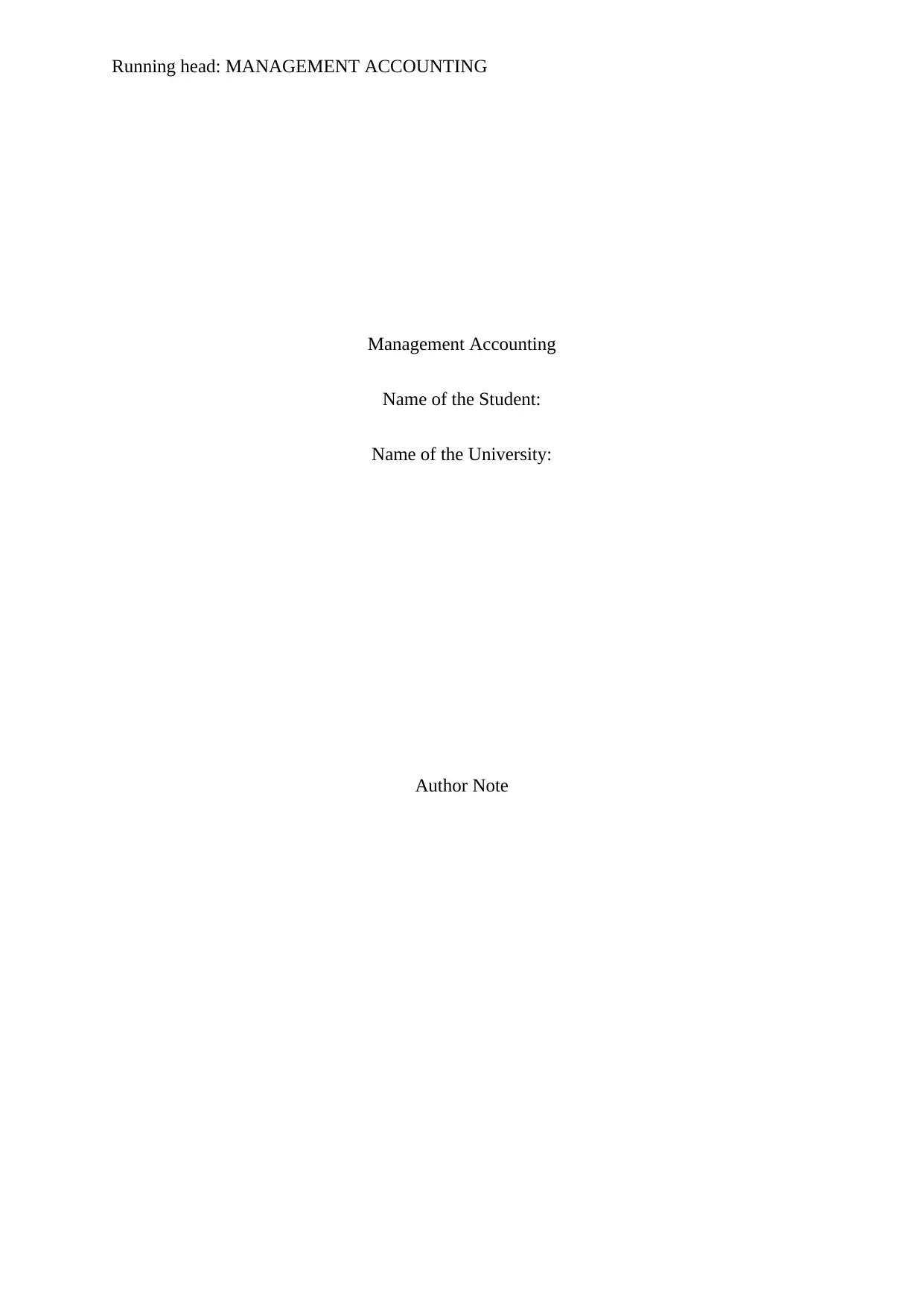
Running head: MANAGEMENT ACCOUNTING
Management Accounting
Name of the Student:
Name of the University:
Author Note
Management Accounting
Name of the Student:
Name of the University:
Author Note
Paraphrase This Document
Need a fresh take? Get an instant paraphrase of this document with our AI Paraphraser
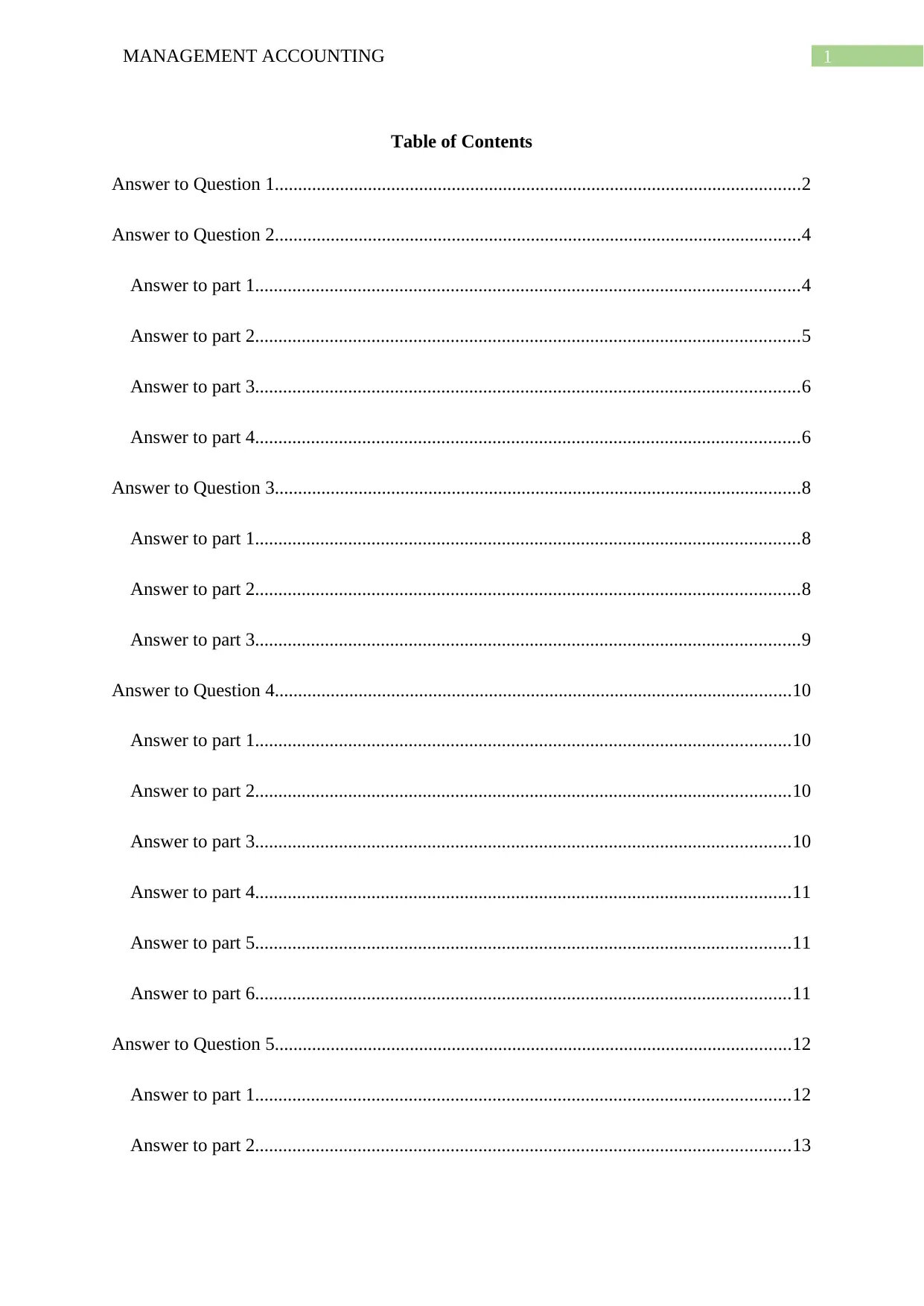
1MANAGEMENT ACCOUNTING
Table of Contents
Answer to Question 1.................................................................................................................2
Answer to Question 2.................................................................................................................4
Answer to part 1.....................................................................................................................4
Answer to part 2.....................................................................................................................5
Answer to part 3.....................................................................................................................6
Answer to part 4.....................................................................................................................6
Answer to Question 3.................................................................................................................8
Answer to part 1.....................................................................................................................8
Answer to part 2.....................................................................................................................8
Answer to part 3.....................................................................................................................9
Answer to Question 4...............................................................................................................10
Answer to part 1...................................................................................................................10
Answer to part 2...................................................................................................................10
Answer to part 3...................................................................................................................10
Answer to part 4...................................................................................................................11
Answer to part 5...................................................................................................................11
Answer to part 6...................................................................................................................11
Answer to Question 5...............................................................................................................12
Answer to part 1...................................................................................................................12
Answer to part 2...................................................................................................................13
Table of Contents
Answer to Question 1.................................................................................................................2
Answer to Question 2.................................................................................................................4
Answer to part 1.....................................................................................................................4
Answer to part 2.....................................................................................................................5
Answer to part 3.....................................................................................................................6
Answer to part 4.....................................................................................................................6
Answer to Question 3.................................................................................................................8
Answer to part 1.....................................................................................................................8
Answer to part 2.....................................................................................................................8
Answer to part 3.....................................................................................................................9
Answer to Question 4...............................................................................................................10
Answer to part 1...................................................................................................................10
Answer to part 2...................................................................................................................10
Answer to part 3...................................................................................................................10
Answer to part 4...................................................................................................................11
Answer to part 5...................................................................................................................11
Answer to part 6...................................................................................................................11
Answer to Question 5...............................................................................................................12
Answer to part 1...................................................................................................................12
Answer to part 2...................................................................................................................13
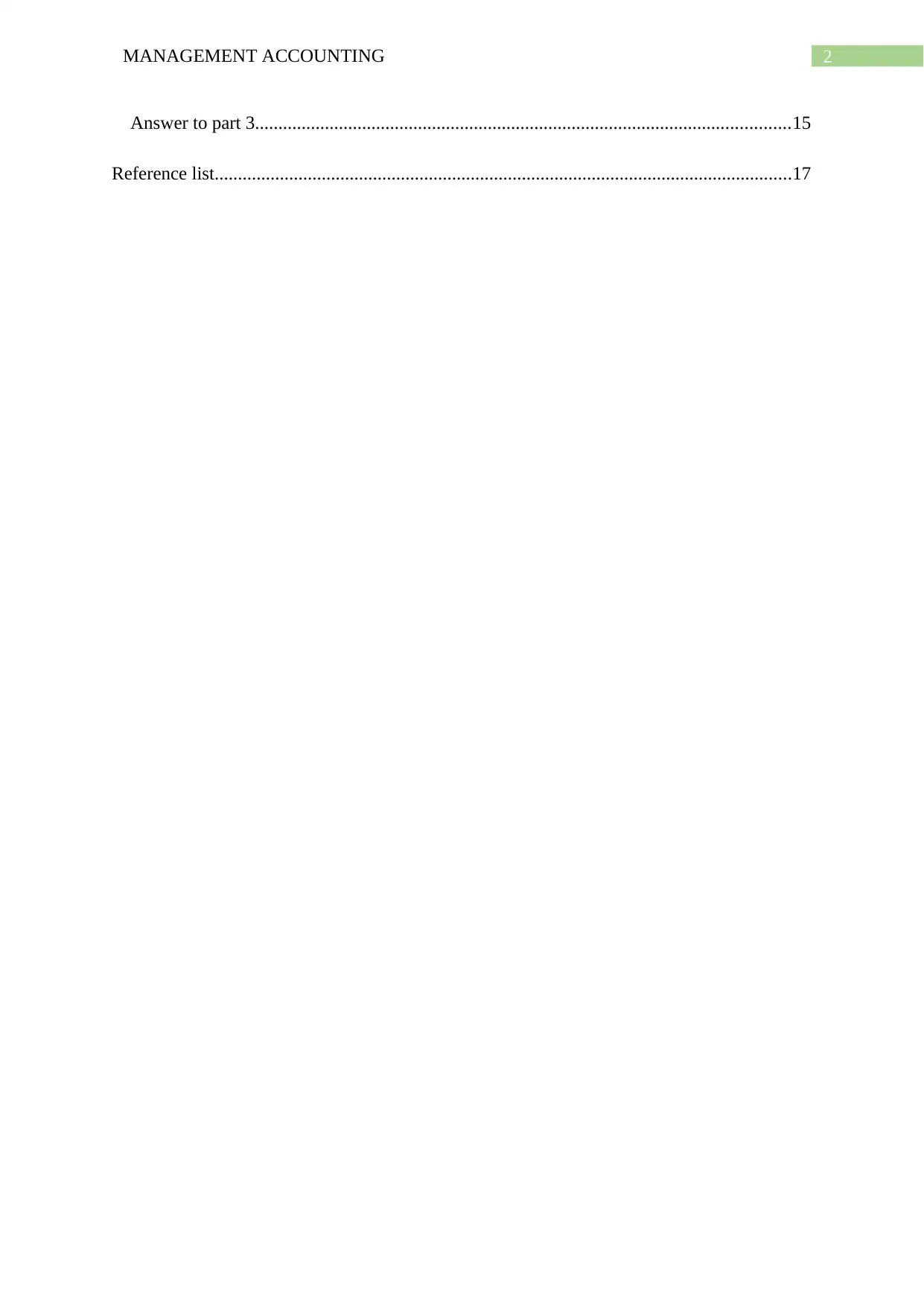
2MANAGEMENT ACCOUNTING
Answer to part 3...................................................................................................................15
Reference list............................................................................................................................17
Answer to part 3...................................................................................................................15
Reference list............................................................................................................................17
⊘ This is a preview!⊘
Do you want full access?
Subscribe today to unlock all pages.

Trusted by 1+ million students worldwide
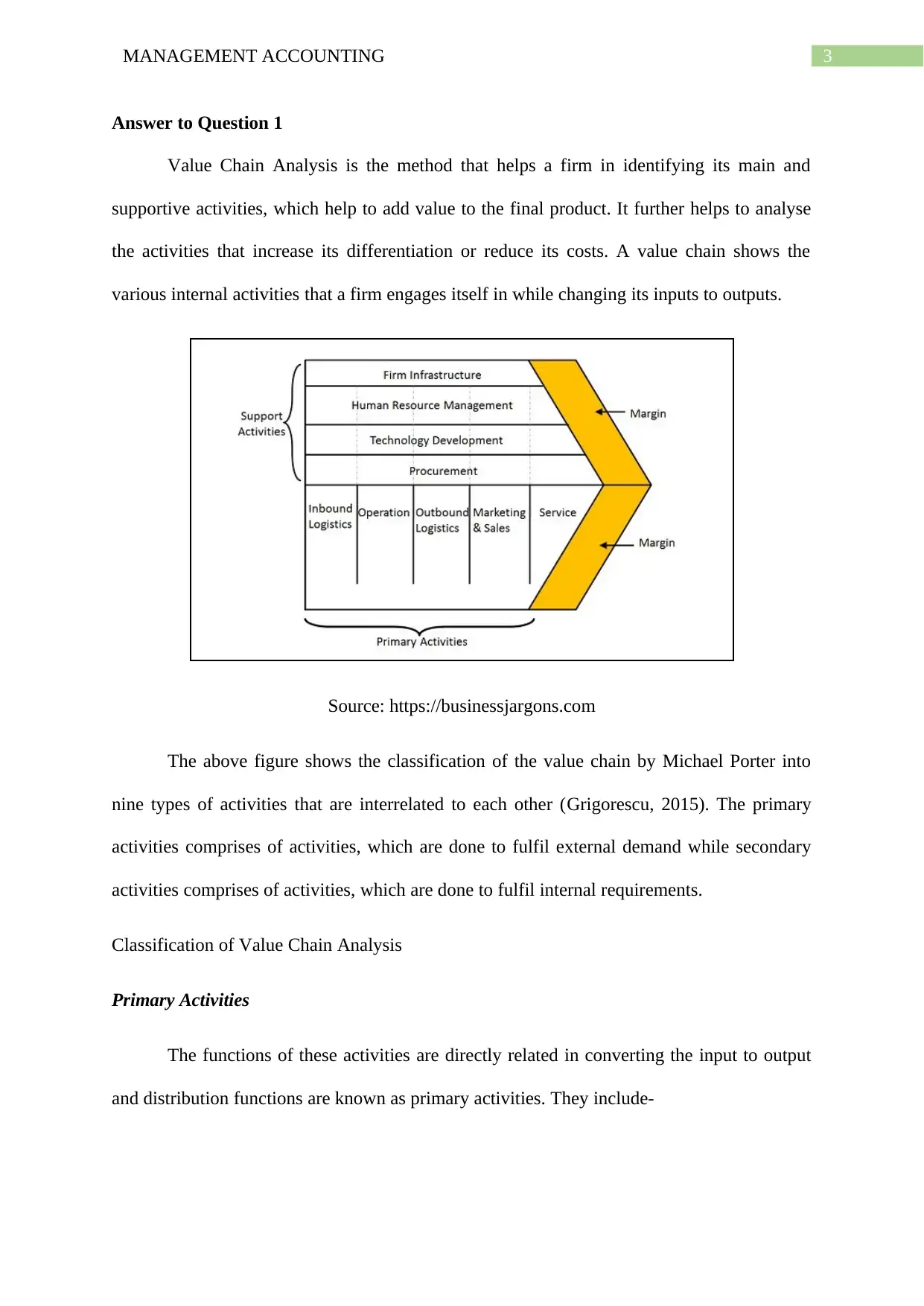
3MANAGEMENT ACCOUNTING
Answer to Question 1
Value Chain Analysis is the method that helps a firm in identifying its main and
supportive activities, which help to add value to the final product. It further helps to analyse
the activities that increase its differentiation or reduce its costs. A value chain shows the
various internal activities that a firm engages itself in while changing its inputs to outputs.
Source: https://businessjargons.com
The above figure shows the classification of the value chain by Michael Porter into
nine types of activities that are interrelated to each other (Grigorescu, 2015). The primary
activities comprises of activities, which are done to fulfil external demand while secondary
activities comprises of activities, which are done to fulfil internal requirements.
Classification of Value Chain Analysis
Primary Activities
The functions of these activities are directly related in converting the input to output
and distribution functions are known as primary activities. They include-
Answer to Question 1
Value Chain Analysis is the method that helps a firm in identifying its main and
supportive activities, which help to add value to the final product. It further helps to analyse
the activities that increase its differentiation or reduce its costs. A value chain shows the
various internal activities that a firm engages itself in while changing its inputs to outputs.
Source: https://businessjargons.com
The above figure shows the classification of the value chain by Michael Porter into
nine types of activities that are interrelated to each other (Grigorescu, 2015). The primary
activities comprises of activities, which are done to fulfil external demand while secondary
activities comprises of activities, which are done to fulfil internal requirements.
Classification of Value Chain Analysis
Primary Activities
The functions of these activities are directly related in converting the input to output
and distribution functions are known as primary activities. They include-
Paraphrase This Document
Need a fresh take? Get an instant paraphrase of this document with our AI Paraphraser
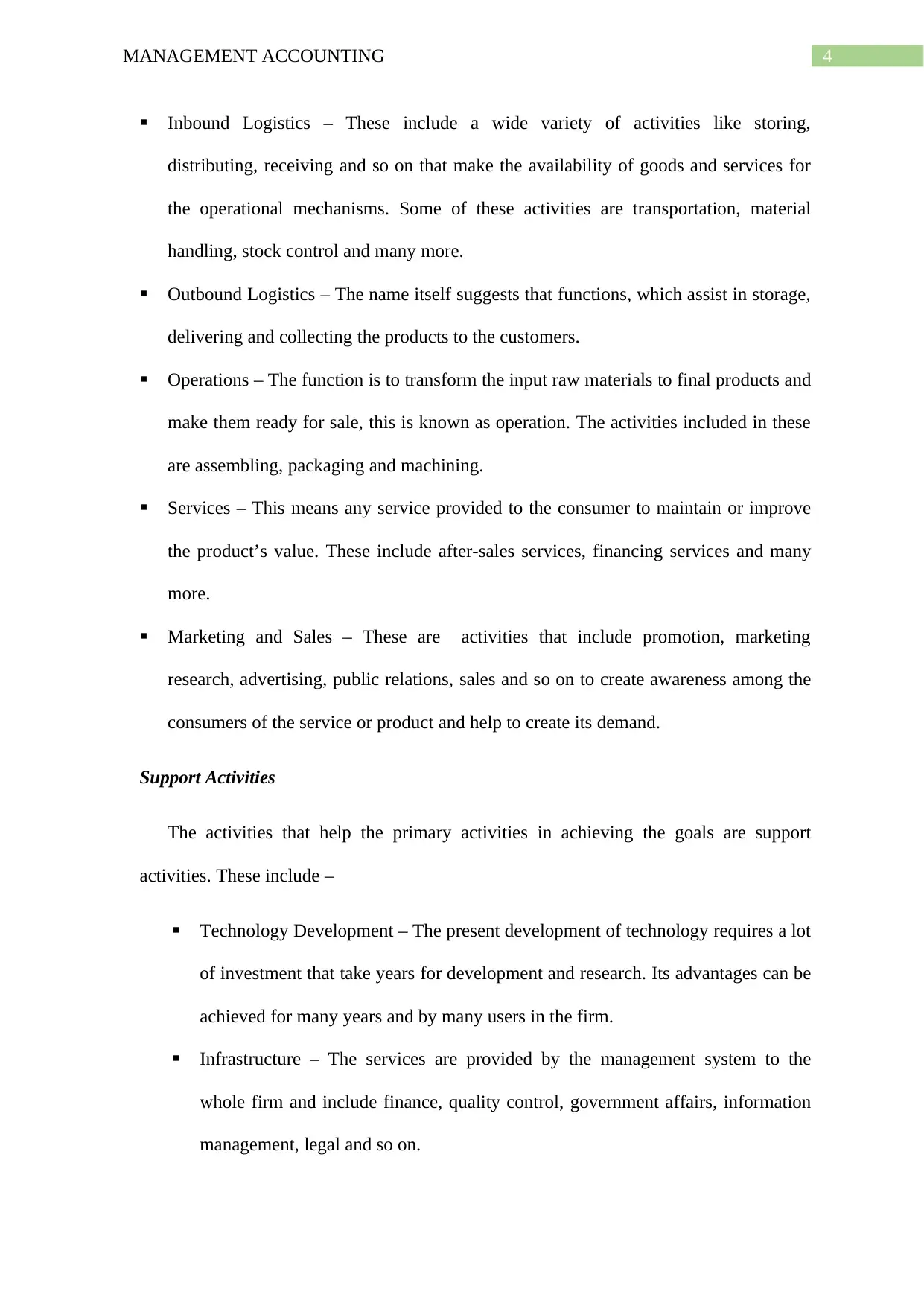
4MANAGEMENT ACCOUNTING
Inbound Logistics – These include a wide variety of activities like storing,
distributing, receiving and so on that make the availability of goods and services for
the operational mechanisms. Some of these activities are transportation, material
handling, stock control and many more.
Outbound Logistics – The name itself suggests that functions, which assist in storage,
delivering and collecting the products to the customers.
Operations – The function is to transform the input raw materials to final products and
make them ready for sale, this is known as operation. The activities included in these
are assembling, packaging and machining.
Services – This means any service provided to the consumer to maintain or improve
the product’s value. These include after-sales services, financing services and many
more.
Marketing and Sales – These are activities that include promotion, marketing
research, advertising, public relations, sales and so on to create awareness among the
consumers of the service or product and help to create its demand.
Support Activities
The activities that help the primary activities in achieving the goals are support
activities. These include –
Technology Development – The present development of technology requires a lot
of investment that take years for development and research. Its advantages can be
achieved for many years and by many users in the firm.
Infrastructure – The services are provided by the management system to the
whole firm and include finance, quality control, government affairs, information
management, legal and so on.
Inbound Logistics – These include a wide variety of activities like storing,
distributing, receiving and so on that make the availability of goods and services for
the operational mechanisms. Some of these activities are transportation, material
handling, stock control and many more.
Outbound Logistics – The name itself suggests that functions, which assist in storage,
delivering and collecting the products to the customers.
Operations – The function is to transform the input raw materials to final products and
make them ready for sale, this is known as operation. The activities included in these
are assembling, packaging and machining.
Services – This means any service provided to the consumer to maintain or improve
the product’s value. These include after-sales services, financing services and many
more.
Marketing and Sales – These are activities that include promotion, marketing
research, advertising, public relations, sales and so on to create awareness among the
consumers of the service or product and help to create its demand.
Support Activities
The activities that help the primary activities in achieving the goals are support
activities. These include –
Technology Development – The present development of technology requires a lot
of investment that take years for development and research. Its advantages can be
achieved for many years and by many users in the firm.
Infrastructure – The services are provided by the management system to the
whole firm and include finance, quality control, government affairs, information
management, legal and so on.
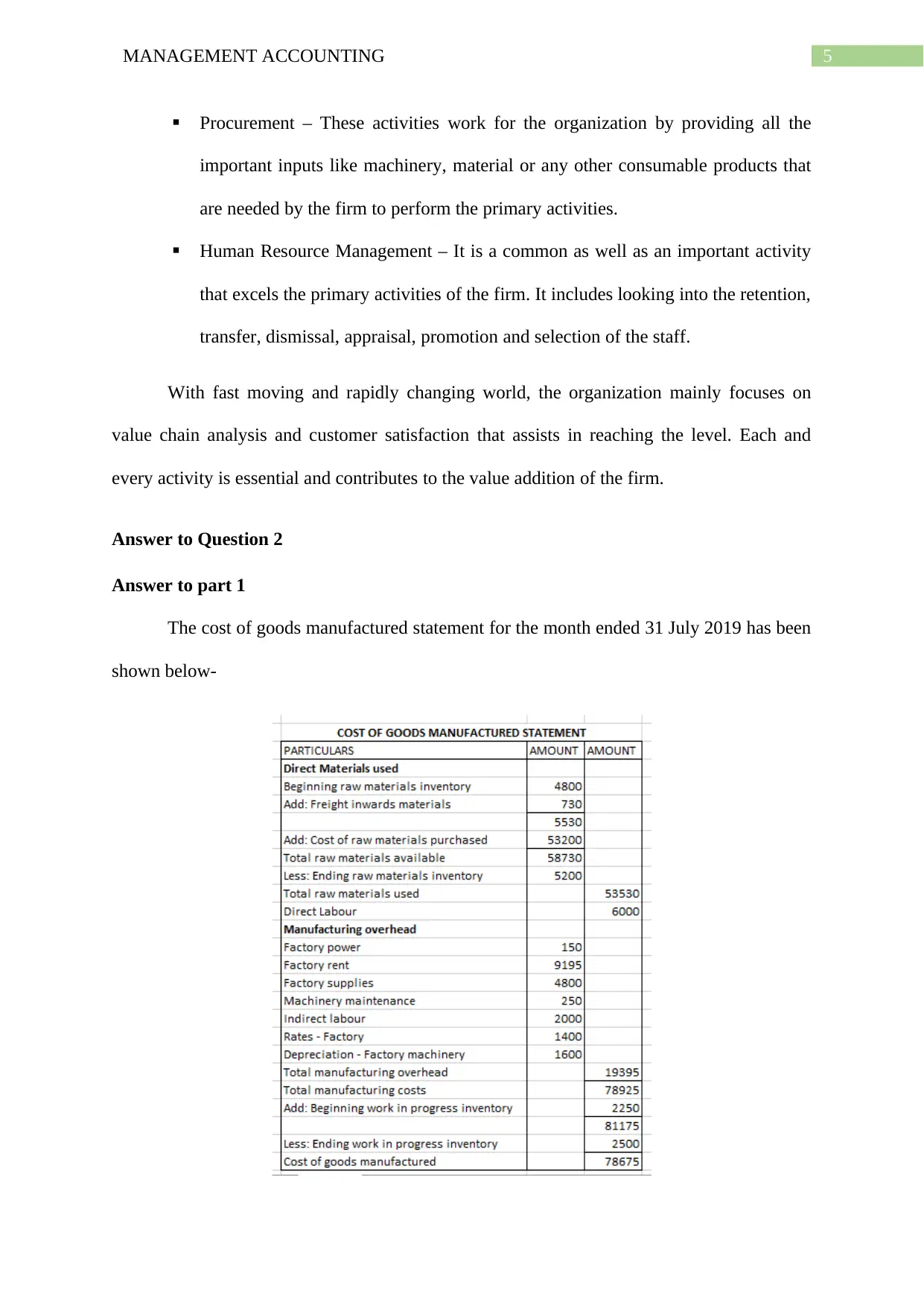
5MANAGEMENT ACCOUNTING
Procurement – These activities work for the organization by providing all the
important inputs like machinery, material or any other consumable products that
are needed by the firm to perform the primary activities.
Human Resource Management – It is a common as well as an important activity
that excels the primary activities of the firm. It includes looking into the retention,
transfer, dismissal, appraisal, promotion and selection of the staff.
With fast moving and rapidly changing world, the organization mainly focuses on
value chain analysis and customer satisfaction that assists in reaching the level. Each and
every activity is essential and contributes to the value addition of the firm.
Answer to Question 2
Answer to part 1
The cost of goods manufactured statement for the month ended 31 July 2019 has been
shown below-
Procurement – These activities work for the organization by providing all the
important inputs like machinery, material or any other consumable products that
are needed by the firm to perform the primary activities.
Human Resource Management – It is a common as well as an important activity
that excels the primary activities of the firm. It includes looking into the retention,
transfer, dismissal, appraisal, promotion and selection of the staff.
With fast moving and rapidly changing world, the organization mainly focuses on
value chain analysis and customer satisfaction that assists in reaching the level. Each and
every activity is essential and contributes to the value addition of the firm.
Answer to Question 2
Answer to part 1
The cost of goods manufactured statement for the month ended 31 July 2019 has been
shown below-
⊘ This is a preview!⊘
Do you want full access?
Subscribe today to unlock all pages.

Trusted by 1+ million students worldwide
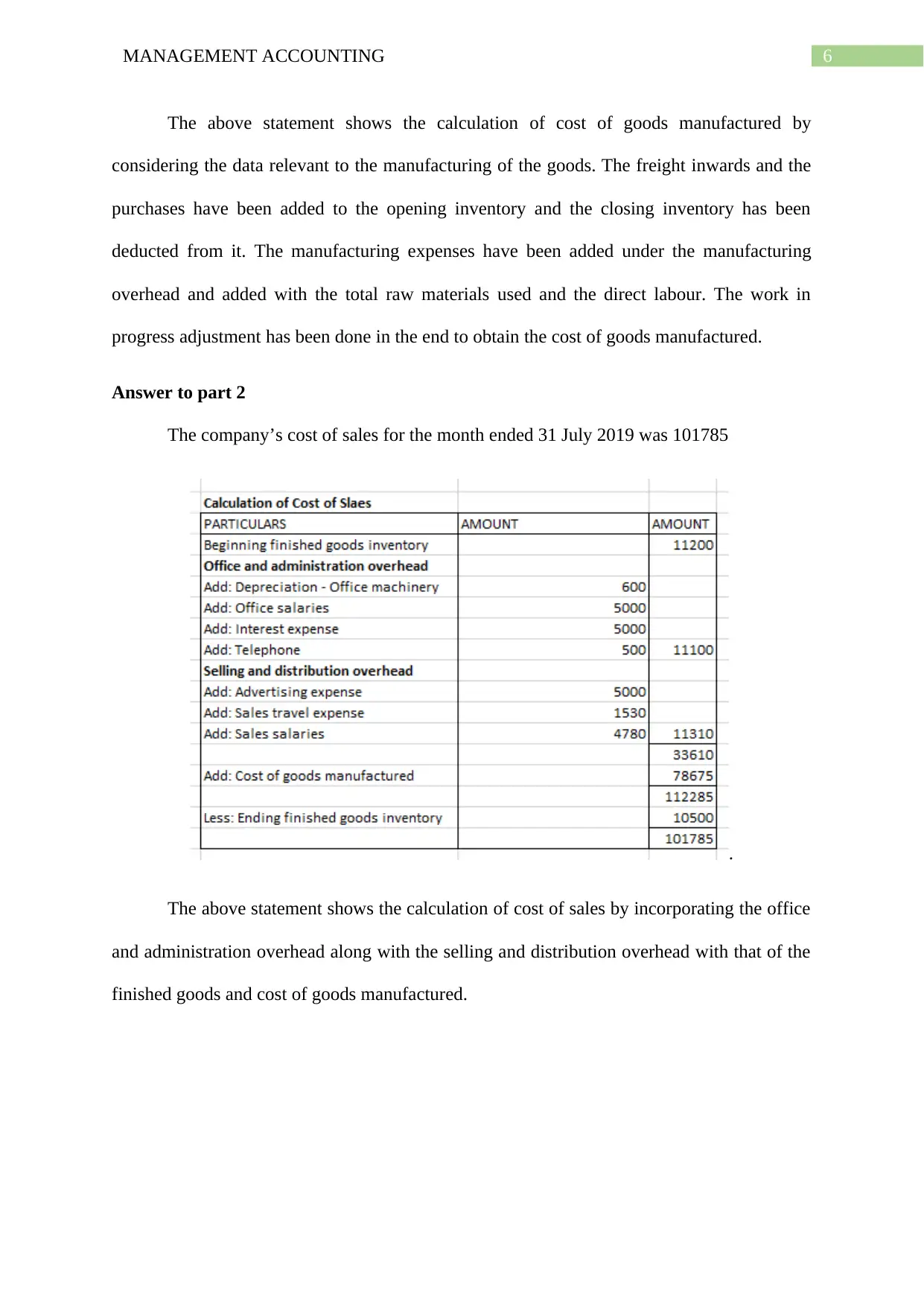
6MANAGEMENT ACCOUNTING
The above statement shows the calculation of cost of goods manufactured by
considering the data relevant to the manufacturing of the goods. The freight inwards and the
purchases have been added to the opening inventory and the closing inventory has been
deducted from it. The manufacturing expenses have been added under the manufacturing
overhead and added with the total raw materials used and the direct labour. The work in
progress adjustment has been done in the end to obtain the cost of goods manufactured.
Answer to part 2
The company’s cost of sales for the month ended 31 July 2019 was 101785
.
The above statement shows the calculation of cost of sales by incorporating the office
and administration overhead along with the selling and distribution overhead with that of the
finished goods and cost of goods manufactured.
The above statement shows the calculation of cost of goods manufactured by
considering the data relevant to the manufacturing of the goods. The freight inwards and the
purchases have been added to the opening inventory and the closing inventory has been
deducted from it. The manufacturing expenses have been added under the manufacturing
overhead and added with the total raw materials used and the direct labour. The work in
progress adjustment has been done in the end to obtain the cost of goods manufactured.
Answer to part 2
The company’s cost of sales for the month ended 31 July 2019 was 101785
.
The above statement shows the calculation of cost of sales by incorporating the office
and administration overhead along with the selling and distribution overhead with that of the
finished goods and cost of goods manufactured.
Paraphrase This Document
Need a fresh take? Get an instant paraphrase of this document with our AI Paraphraser
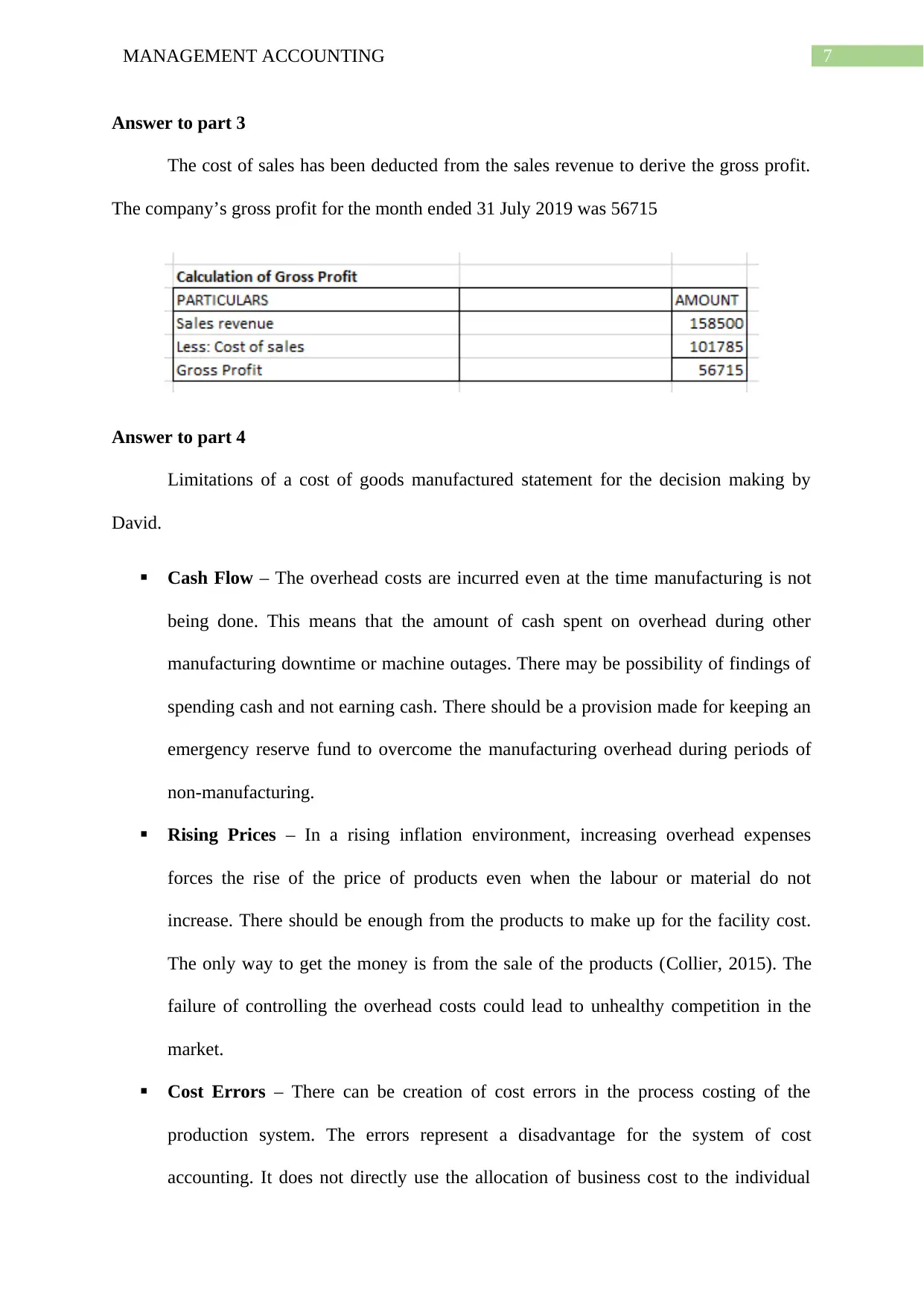
7MANAGEMENT ACCOUNTING
Answer to part 3
The cost of sales has been deducted from the sales revenue to derive the gross profit.
The company’s gross profit for the month ended 31 July 2019 was 56715
Answer to part 4
Limitations of a cost of goods manufactured statement for the decision making by
David.
Cash Flow – The overhead costs are incurred even at the time manufacturing is not
being done. This means that the amount of cash spent on overhead during other
manufacturing downtime or machine outages. There may be possibility of findings of
spending cash and not earning cash. There should be a provision made for keeping an
emergency reserve fund to overcome the manufacturing overhead during periods of
non-manufacturing.
Rising Prices – In a rising inflation environment, increasing overhead expenses
forces the rise of the price of products even when the labour or material do not
increase. There should be enough from the products to make up for the facility cost.
The only way to get the money is from the sale of the products (Collier, 2015). The
failure of controlling the overhead costs could lead to unhealthy competition in the
market.
Cost Errors – There can be creation of cost errors in the process costing of the
production system. The errors represent a disadvantage for the system of cost
accounting. It does not directly use the allocation of business cost to the individual
Answer to part 3
The cost of sales has been deducted from the sales revenue to derive the gross profit.
The company’s gross profit for the month ended 31 July 2019 was 56715
Answer to part 4
Limitations of a cost of goods manufactured statement for the decision making by
David.
Cash Flow – The overhead costs are incurred even at the time manufacturing is not
being done. This means that the amount of cash spent on overhead during other
manufacturing downtime or machine outages. There may be possibility of findings of
spending cash and not earning cash. There should be a provision made for keeping an
emergency reserve fund to overcome the manufacturing overhead during periods of
non-manufacturing.
Rising Prices – In a rising inflation environment, increasing overhead expenses
forces the rise of the price of products even when the labour or material do not
increase. There should be enough from the products to make up for the facility cost.
The only way to get the money is from the sale of the products (Collier, 2015). The
failure of controlling the overhead costs could lead to unhealthy competition in the
market.
Cost Errors – There can be creation of cost errors in the process costing of the
production system. The errors represent a disadvantage for the system of cost
accounting. It does not directly use the allocation of business cost to the individual
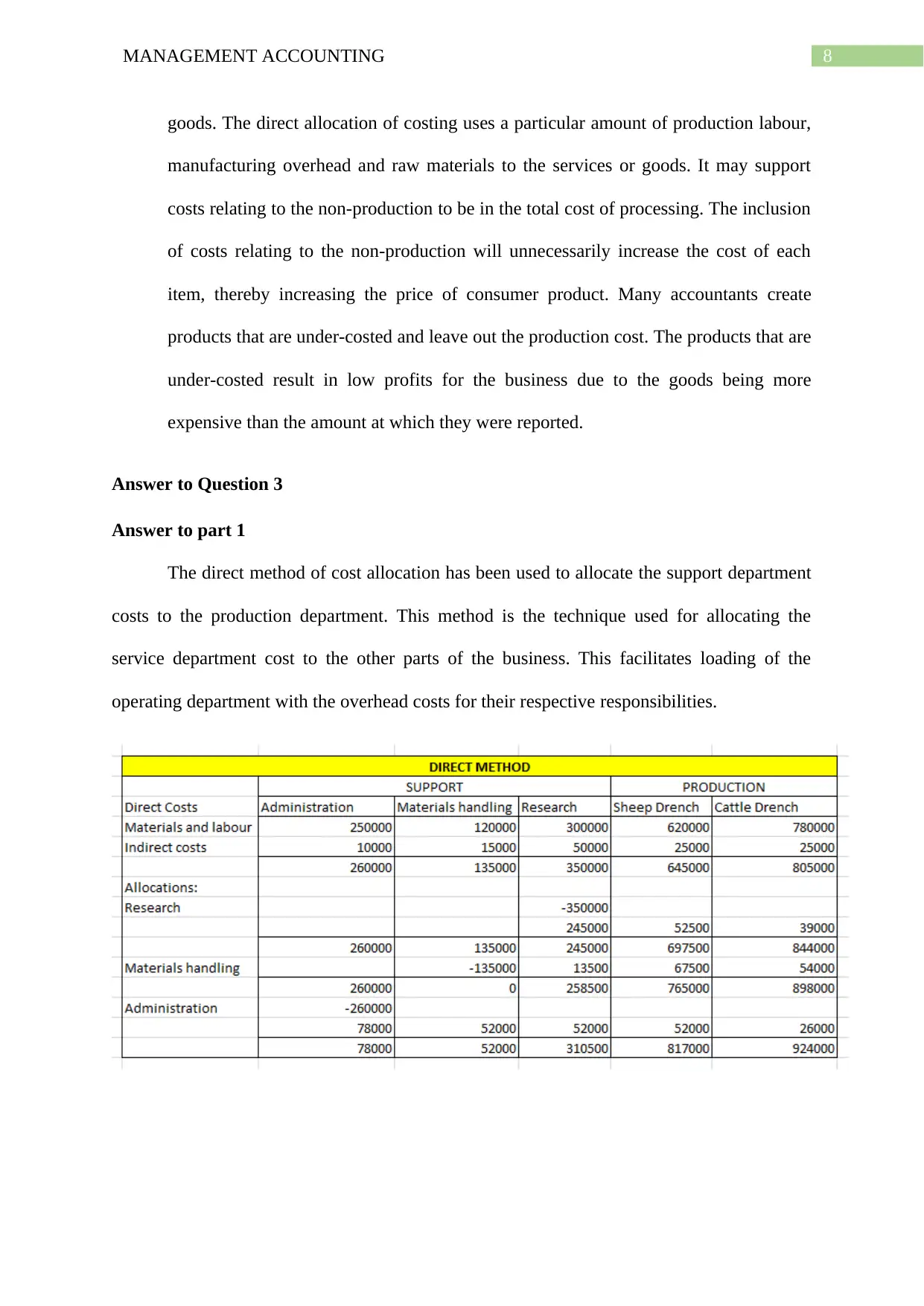
8MANAGEMENT ACCOUNTING
goods. The direct allocation of costing uses a particular amount of production labour,
manufacturing overhead and raw materials to the services or goods. It may support
costs relating to the non-production to be in the total cost of processing. The inclusion
of costs relating to the non-production will unnecessarily increase the cost of each
item, thereby increasing the price of consumer product. Many accountants create
products that are under-costed and leave out the production cost. The products that are
under-costed result in low profits for the business due to the goods being more
expensive than the amount at which they were reported.
Answer to Question 3
Answer to part 1
The direct method of cost allocation has been used to allocate the support department
costs to the production department. This method is the technique used for allocating the
service department cost to the other parts of the business. This facilitates loading of the
operating department with the overhead costs for their respective responsibilities.
goods. The direct allocation of costing uses a particular amount of production labour,
manufacturing overhead and raw materials to the services or goods. It may support
costs relating to the non-production to be in the total cost of processing. The inclusion
of costs relating to the non-production will unnecessarily increase the cost of each
item, thereby increasing the price of consumer product. Many accountants create
products that are under-costed and leave out the production cost. The products that are
under-costed result in low profits for the business due to the goods being more
expensive than the amount at which they were reported.
Answer to Question 3
Answer to part 1
The direct method of cost allocation has been used to allocate the support department
costs to the production department. This method is the technique used for allocating the
service department cost to the other parts of the business. This facilitates loading of the
operating department with the overhead costs for their respective responsibilities.
⊘ This is a preview!⊘
Do you want full access?
Subscribe today to unlock all pages.

Trusted by 1+ million students worldwide
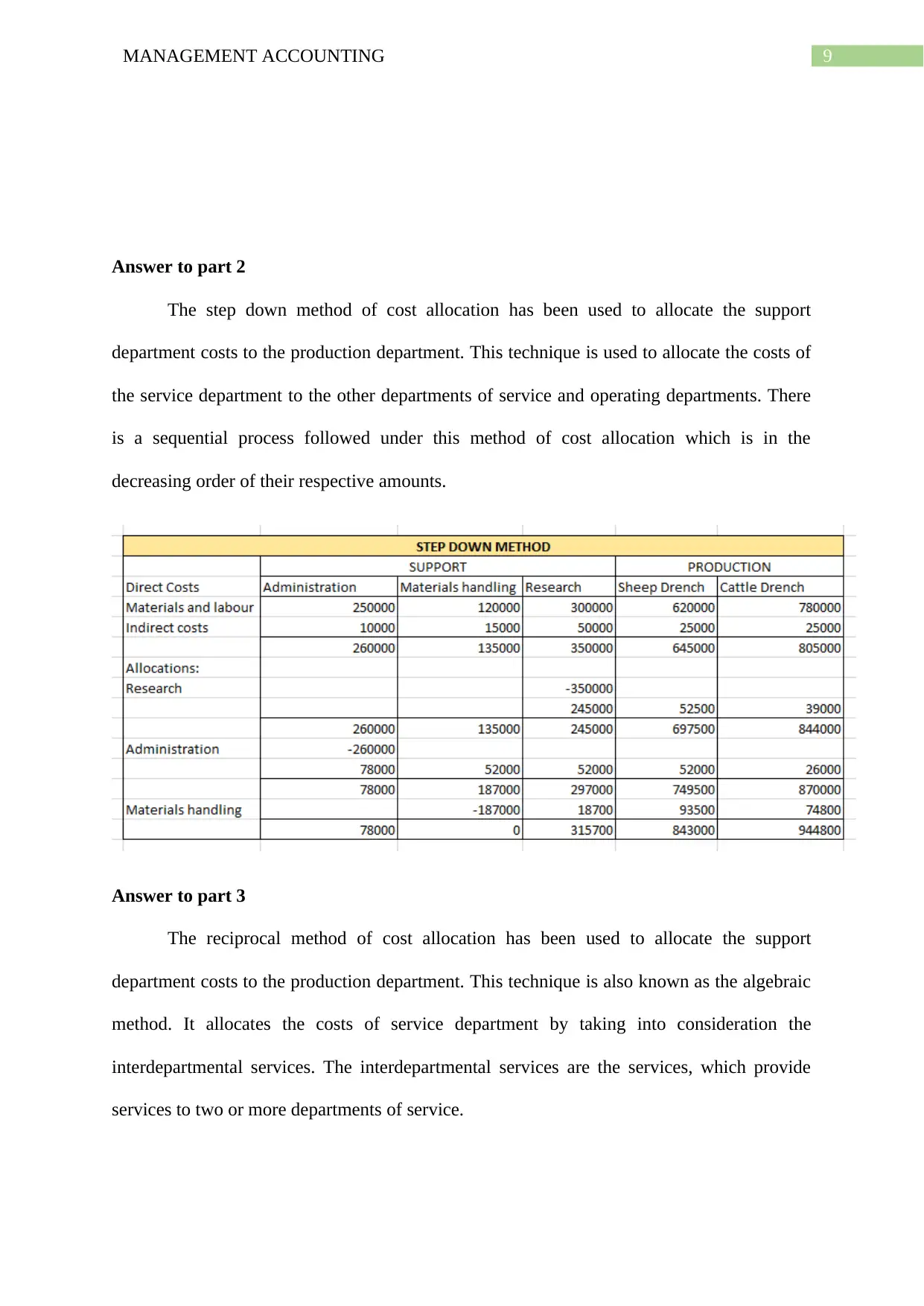
9MANAGEMENT ACCOUNTING
Answer to part 2
The step down method of cost allocation has been used to allocate the support
department costs to the production department. This technique is used to allocate the costs of
the service department to the other departments of service and operating departments. There
is a sequential process followed under this method of cost allocation which is in the
decreasing order of their respective amounts.
Answer to part 3
The reciprocal method of cost allocation has been used to allocate the support
department costs to the production department. This technique is also known as the algebraic
method. It allocates the costs of service department by taking into consideration the
interdepartmental services. The interdepartmental services are the services, which provide
services to two or more departments of service.
Answer to part 2
The step down method of cost allocation has been used to allocate the support
department costs to the production department. This technique is used to allocate the costs of
the service department to the other departments of service and operating departments. There
is a sequential process followed under this method of cost allocation which is in the
decreasing order of their respective amounts.
Answer to part 3
The reciprocal method of cost allocation has been used to allocate the support
department costs to the production department. This technique is also known as the algebraic
method. It allocates the costs of service department by taking into consideration the
interdepartmental services. The interdepartmental services are the services, which provide
services to two or more departments of service.
Paraphrase This Document
Need a fresh take? Get an instant paraphrase of this document with our AI Paraphraser
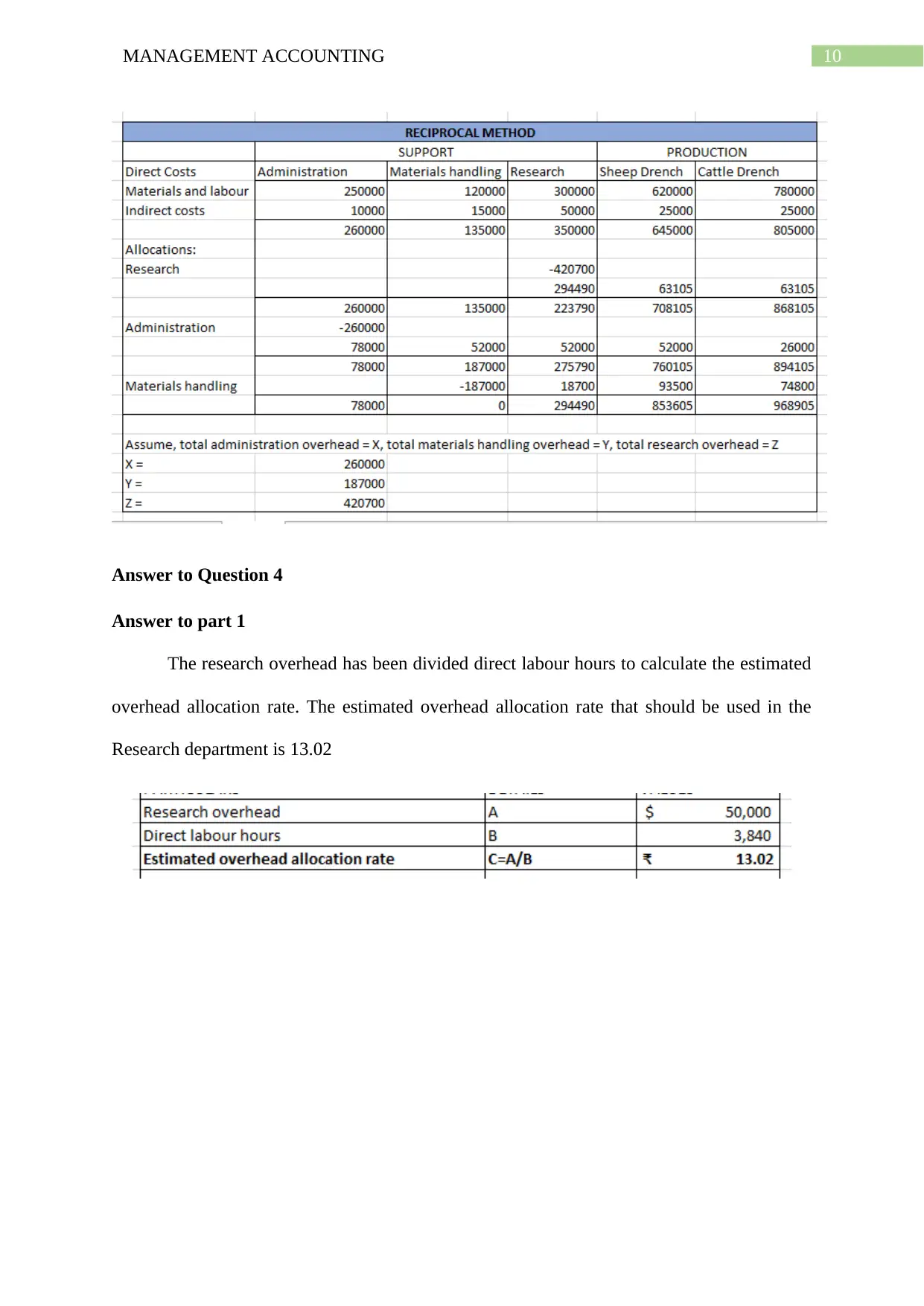
10MANAGEMENT ACCOUNTING
Answer to Question 4
Answer to part 1
The research overhead has been divided direct labour hours to calculate the estimated
overhead allocation rate. The estimated overhead allocation rate that should be used in the
Research department is 13.02
Answer to Question 4
Answer to part 1
The research overhead has been divided direct labour hours to calculate the estimated
overhead allocation rate. The estimated overhead allocation rate that should be used in the
Research department is 13.02
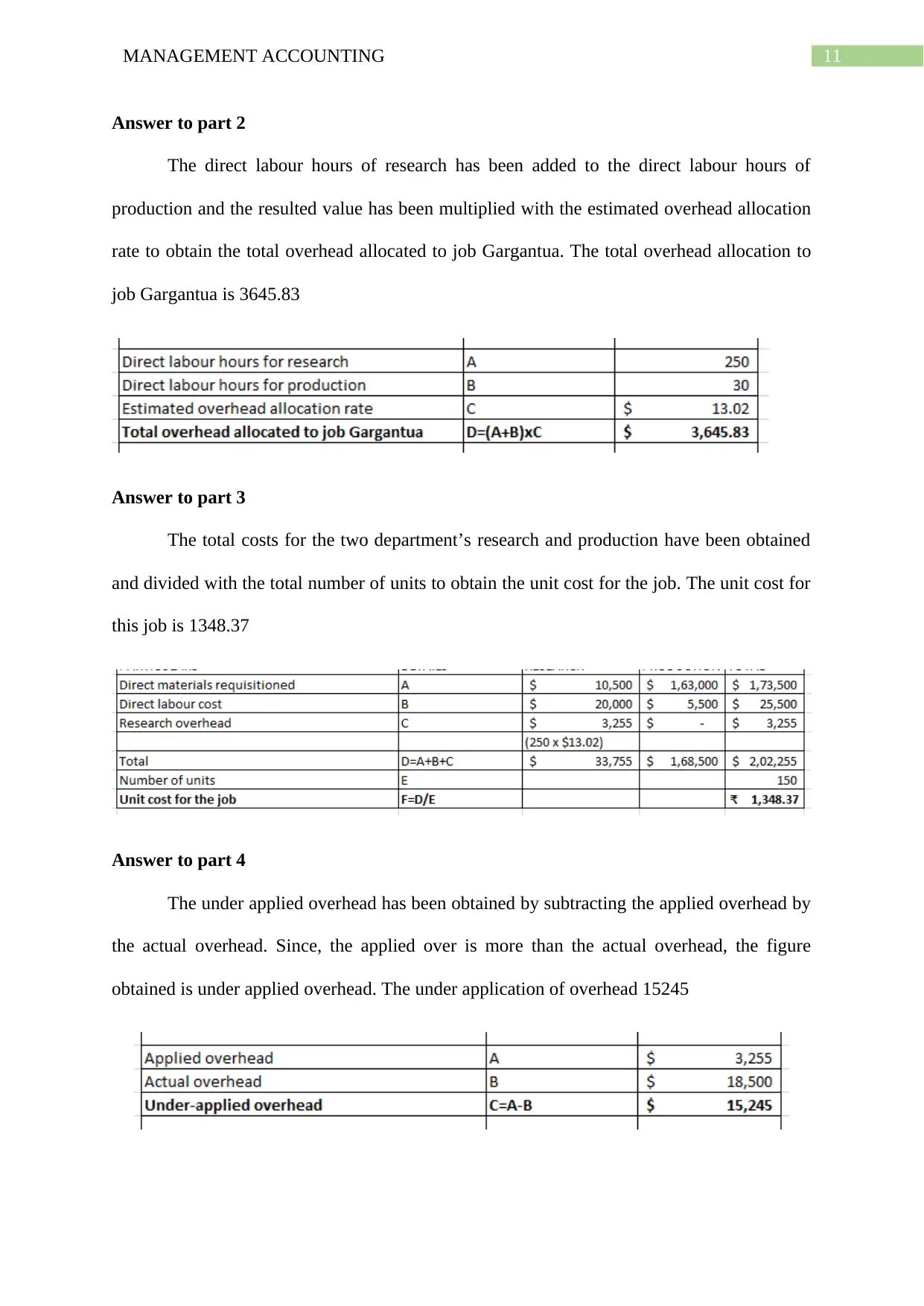
11MANAGEMENT ACCOUNTING
Answer to part 2
The direct labour hours of research has been added to the direct labour hours of
production and the resulted value has been multiplied with the estimated overhead allocation
rate to obtain the total overhead allocated to job Gargantua. The total overhead allocation to
job Gargantua is 3645.83
Answer to part 3
The total costs for the two department’s research and production have been obtained
and divided with the total number of units to obtain the unit cost for the job. The unit cost for
this job is 1348.37
Answer to part 4
The under applied overhead has been obtained by subtracting the applied overhead by
the actual overhead. Since, the applied over is more than the actual overhead, the figure
obtained is under applied overhead. The under application of overhead 15245
Answer to part 2
The direct labour hours of research has been added to the direct labour hours of
production and the resulted value has been multiplied with the estimated overhead allocation
rate to obtain the total overhead allocated to job Gargantua. The total overhead allocation to
job Gargantua is 3645.83
Answer to part 3
The total costs for the two department’s research and production have been obtained
and divided with the total number of units to obtain the unit cost for the job. The unit cost for
this job is 1348.37
Answer to part 4
The under applied overhead has been obtained by subtracting the applied overhead by
the actual overhead. Since, the applied over is more than the actual overhead, the figure
obtained is under applied overhead. The under application of overhead 15245
⊘ This is a preview!⊘
Do you want full access?
Subscribe today to unlock all pages.

Trusted by 1+ million students worldwide
1 out of 18
Related Documents
Your All-in-One AI-Powered Toolkit for Academic Success.
+13062052269
info@desklib.com
Available 24*7 on WhatsApp / Email
![[object Object]](/_next/static/media/star-bottom.7253800d.svg)
Unlock your academic potential
Copyright © 2020–2025 A2Z Services. All Rights Reserved. Developed and managed by ZUCOL.





